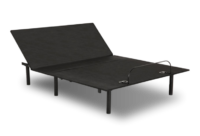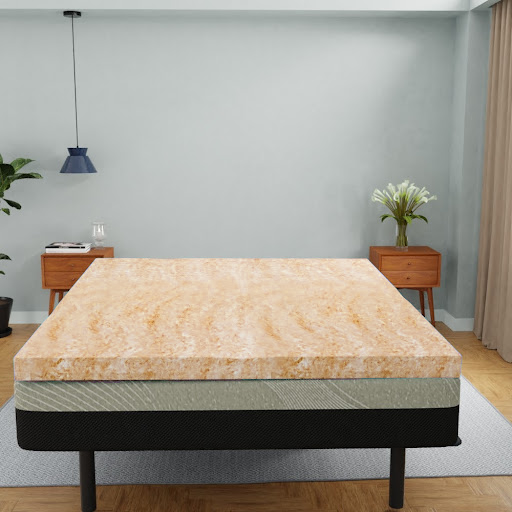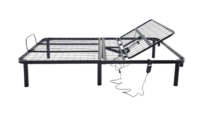FAQs

Frequently Asked Questions
General
- Twin: 39″ wide x 75″ long
- Twin Extra Long: 39″ wide x 80″ long
- Full: 54″ wide x 75″ long
- Full Extra long: 54″ wide x 80″ long
- Queen: 60″ wide x 80″ long
- King: 76″ wide x 80″ long
- California King: 72″ wide x 84″ long
Not necessary. BUT, if you don’t purchase a new protector at the time of your mattress purchase, your warranty claim process may be at risk. All manufacturers’ warranties are void if the mattress has any type of stain/soiling. It is a much easier warranty claim process if your mattress protector is on the same receipt as your mattress. Also, mattress protectors can wear out over time and may not actually protect your mattress. Mattress protectors aren’t just for warranty claim protection, they help you and your mattress stay healthy.
The short answer is yes, especially if the foundation you currently own is not the same type of support required under the new mattress. Foundations do wear out, although, they do not show the wear like the mattress. All new mattresses as of July 1, 2007 have to meet federal fire safety guidelines. You may still purchase a mattress only, but it may not meet the fire safety standards on your old box spring. Generally, about 80% of the set cost is in the mattress, so why not get the proper matching foundation. It is not only a cost issue, but also a safety issue, so we recommend buying the matching set.
Most mattresses come with a 10-year manufacturers warranty. The warranty is designed to protect you in case of a defect, but it does not cover comfort. You should consider a new bed every 7 to 10 years. Back in the 1970s and 80s, mattresses were approximately 8″ thick, on average. The springs would not matt down and there was very little padding so people tended to keep them longer. Over the years, inner springs have not changed thickness much; they are still about 6″ to 7”. Today’s mattresses, however, are much thicker, on average between 10″ and 15″ thick. They are much more comfortable and offer a wider variety of comfort levels. They are also now one-sided, and the upholstery life is about 7 to 10 years.
We encourage you to think about these things and ask yourself the following questions:
- Are you sleeping better or worse than you did a year ago?
- Are you waking up feeling stiff and sore?
- Does your mattress have visible signs of wear and tear?
- Would a new mattress improve your sleep?
If the answer is “yes” to any of these questions, then it’s time to consider purchasing a new mattress. And because people tend to overlook their mattresses and don’t think about them, we recommend that you “check” your mattress using these four questions on a regular basis – at least twice a year – to make sure mattress wear and tear isn’t sneaking up on you and disrupting your sleep.
The best way to shop is to determine a budget, but keep an open mind; you might like a better product. First off, find a mattress expert that you can trust, one that actually cares about your needs, all Mattress TODAY USA locations are locally owned and operated with a Customer First mentality.
Wear comfortable clothing and be prepared to spend 10 to 15 minutes on your favorite models. Never wander around pressing beds with your hands or knees because this will tell you nothing about the true feel of the mattress. Allow the salesperson to guide you. A good salesperson asks many questions and should have all the answers to your bedding questions. You must spend quality time on the different models. Try the SLEEP Test:
Select a mattress
Lie down in your sleep position
Evaluate the level of comfort and support
Educate yourself about each selection
Partners should shop together
Don’t be embarrassed. You wouldn’t think twice about test-driving a car, and you shouldn’t think twice about “SLEEP Testing” a mattress. Lie down on the mattress for several minutes, if you sleep on your back and your side, try it on your back and your side. Assess the support it provides and how comfortable it is for you. The only way to tell if a mattress is right for you is to lie down on it.
There are many different components that go into a mattress, and most mattresses today are made with coil springs and various layers of foam above them. A growing number of mattresses are now made with latex or visco-elastic memory foam. Some use both of these materials combined.
You will hear so many buzzwords when shopping for a new mattress. It might be hard to keep them all straight. Here are a few terms to help you out:
- Innerspring Unit: A coil and wire unit that makes up the supportive heart of most mattresses.
- Coil Count: The number of innerspring coils in a mattress.
- Coil Gauge: The thickness of the wire used in innerspring mattresses and border wires. A lower gauge number denotes a thicker wire and a firmer mattress feel. A higher gauge results in a plusher, more conforming feel.
- Comfort Layers: Foam, padding and fiber blended layers added above an innerspring system to provide cushioning; also called upholstery layers.
- Latex Foam: Natural body-conforming material often used to increase softness and relieve pressure points.
- Visco Memory Foam: Synthetic man made material that responds to your body using temperature and weight.
- Hybrid: A hybrid mattress will typically have coils (usually individually pocketed coils) and memory foam and/or latex on top.
- Adjustable Base: Adjustables are great for people who need to elevate their heads to ease sleep apnea, snoring or elevate their feet for circulation and back pain.
We do not list prices of individual mattress we have in the store for a few reasons:
- Some stores are smaller than others and do not have every bed available on their floor. We don’t want to list something that is not available in your area.
- Models can change at any time. We are always on the lookout for new and improved components and can make frequent changes in the mattresses we offer.
- Finally, some stores have greater shipping costs. Everything sold in Washington comes by common carrier or the manufacturer’s truck. At Mattress Today USA, we believe in honest pricing, we don’t inflate prices in one area to make up for another.
- For these reasons we only put the collection description on our website and not the prices and components in each mattress.
Sleep Well Friends!
The answer is a matter of individual taste. What’s best for me may not be best for you. When it comes to mattresses, there is no one-size-fits-all. After all, we’re all built differently and have different comfort and support preferences, so why would the same mattress be “best” for all of us?
To determine the mattress that’s best for you, we recommend using the process of elimination to weed out the ones you don’t like. Go to a retailer and use the “rest test” to narrow down your choices. As you lie down on the mattresses, pay attention to three of the mattress’s most important features: comfort, support and space. The mattress that best fulfills the combination of these needs is the “best” mattress for you. If you sleep with a partner, bring that person with you to test out the mattresses. After all, you will need to reconcile what you like best with what your partner likes best.
You need to understand your needs before you start shopping. We recommend that you think about your lifestyle. How has it changed since you last bought a mattress and how might these changes affect your purchase? And what about your body? Has it changed and how has this affected your needs for support or your comfort preferences? Finally, think about space needs and if you have a partner, take your partner with you to shop for a new mattress. It’s important to find something to meet both your support needs and comfort preferences.
Armed with this information, go to a mattress retailer you trust, someone who will answer your questions with information. Then, take a “rest test” to compare the feel of different mattresses by lying down on them. You will quickly find some mattresses you like and others that do not meet your personal comfort preferences and support needs. Through this process of elimination, you can determine which mattresses you like best.
Your body should tell you when it’s time for a new one – but are you paying attention? If you regularly wake up feeling stiff and sore or if you aren’t sleeping as well as you did a year ago, it may be time to replace what you’re sleeping on. At least twice a year, check for visible signs of wear and tear and ask yourself if you’re sleeping better or worse than you did a year ago and if a new mattress might improve your sleep. This regular sleep check-up will help ensure your mattress is still doing its job.
Your rest – the amount and quality of your sleep – is a critical factor in your overall well-being. It can affect how you feel physically and mentally as well as your productivity. Accordingly, we urge you to invest in your rest, and spend enough on a mattress to ensure that your individual comfort and support needs are being met.
If you figure a seven year lifespan, a $500 mattress will cost less than $.20 a night, a $1,000 mattress costs $.39 a night, a $2,000 mattress only $.78 per night, a $3,000 mattress only $1.17 per night! That’s less than a cup of coffee! Be sure not to shortchange yourself out of a good, quality night’s sleep and buy the best mattress you can afford. The average person spends one-third of his or her life in bed. This equals 220,000 hours over the course of a lifetime! And the mattress is the most used piece of furniture in the home.
Couples should sleep in a queen or king-size mattress for free, easy movement. Couples who sleep on a full mattress are only allowing themselves the same room to move around as a baby has in a crib. And make sure to take your partner with you when you shop for a mattress. It’s important that you find one that meets both your support needs and comfort preferences.
If a mattress is no longer comfortable for you, it’s not good enough for someone else – especially your child. As kids grow, they need supportive and comfortable bedding as well. Be sure your children have enough space to move around comfortably as they grow. In addition, your child’s first “big girl” or “big boy” bed is a great time to teach kids about proper sleeping habits.
Sleep Questions
Next to your new mattress set, the most important item is your bed frame support. Mattresses conform to what they are placed on, so indentations in mattresses are often caused by improper frame support. Check all wheels or glides to make sure they are not broken. Queen and king mattress warranties require a rigid center support with at least one leg touching the ground in the center. If in doubt, please error on the side of caution and purchase a new support for your new mattress set.
Sleep is a key part of a healthy lifestyle. Like eating right and exercising, sleeping well is essential to feeling your best during the day. It affects how you feel, your relationships, your productivity and your quality of life. While you sleep, your brain goes to work, consolidating the day’s learning into memory and reenergizing the body.
There’s nothing wrong with taking a short nap to help refresh you during the day. But if you find you’re napping all the time, it could be a sign that you aren’t getting as much sleep as you should. Or that you’re not getting the deep, restful sleep you need at night.
The mattress has the potential either to encourage sleep or rob you of sleep. Whether your mattress is a sleep friend or a sleep foe can determine how refreshed you feel in the morning. If you’re tossing and turning more at night or if you’re waking up feeling stiff or sore after a night’s sleep, it could be a sign that your current mattress is no longer the best for you. Your body appreciates a comfortable, supportive mattress and will let you know if it’s not up to the task.
The average person needs 7-8 hours a night, but it differs for every person. Some people may need as much as 10 hours a night and others need much less. If you sleep longer on the weekends than during the week, you probably aren’t getting the sleep you need every night.
A few key things should help. Try going to bed and getting up at the same time every day – even on the weekends. This will help keep your biological clock in sync. Develop a sleep ritual by doing the same things each night just before bed. Parents often establish a routine for their kids, but it can help adults, too. A routine cues the body to settle down for the night. Another hint: Unwind early in the evening so that worries and distractions don’t keep you from getting a good night’s sleep. Finally, create a restful sleep environment – sleep in a cool, quiet, dark room on a comfortable, supportive mattress and foundation – to get your best night’s rest. If you’re sleeping as much as you need, but still find that you’re sleepy during the day, you should consult your doctor to see if you might have a medical condition interfering with your sleep.
Sleep needs to be a health priority. It affects every aspect of your day-to-day living. If you can’t say “yes” to sleep, make sure to make the most out of the sleep you get. Exercise regularly – people who exercise a few times a week sleep better than people who don’t. Also, avoid caffeine, alcohol and tobacco products late in the day. All can interfere with sleep. You need to create a restful sleep environment so the sleep you get is restorative and uninterrupted. Sleep in a dark room, on a comfortable, supportive mattress. Keep the room cool and quiet. And if you find yourself too stressed to sleep, make a list of all the things you need to do. Once you’ve made your to-do list, give yourself permission to relax and sleep. You’ll need the energy to tackle your tasks in the morning.
Anyone who sleeps during the day needs to make sure their room is dark – use heavy window coverings to block out the light. This is important for everyone, but particularly for people who sleep when it’s bright outside. Also, make sure your room is cool, between 60 to 65 degrees Fahrenheit (16 to 18 degrees Celsius). Sleep on a comfortable, supportive mattress and foundation that offers you enough space to move around comfortably. And sleep in a room that’s quiet. The sleep environment is a very controllable part of good sleep – whether you’re sleeping during the day or at night. You can adjust the temperature, replace an uncomfortable or worn-out mattress, block out noise with earplugs or a white noise machine and keep light from your bedroom with dark blinds or eye shades.
If you regularly fall asleep on your sofa, you may not be getting as much sleep as you need at night in your bed. Or maybe your sofa is more comfortable than your bed! In either case, you should make sure to practice good sleep habits – from sleeping on a comfortable, supportive mattress to not drinking alcohol too close to bedtime. And try to get more sleep – it may change how you feel during the day.
If you’ve looked at your sleep environment and your everyday routine to make sure you’re not sabotaging your sleep and you still feel sleepy after getting a full night’s sleep, you should see your doctor. You may have a medical condition that interferes with getting a good night’s sleep.
There’s nothing more challenging than taking care of a new baby. The good news is, as babies grow older, they sleep for far longer periods at a time and soon will sleep through the night. In the meantime, know that erratic sleep schedules and getting up in the middle of the night will be part of your lives for the next few months. So make the most of the sleep you can get – provide yourself and your husband with a restful sleep environment. Sleep in a cool, dark room on a comfortable, supportive mattress. That way, you’ll get the best sleep you can, even if it’s for shorter periods of time. And learn to sleep when your baby does. It may be tempting to tackle chores while your baby sleeps, but a quick nap will help boost your energy. Sleep is as important to you as it is to your child.
Kids need at least nine hours of sleep each night to be star students. To help make sure your kids get the sleep they need, make sure your child’s bedroom is conducive to a good night’s sleep – your child’s room should be cool, quiet and dark and he or she should be sleeping on a comfortable, supportive mattress.






